Table of Contents
Introduction: Why Material Choice Matters
Raised garden beds are one of the most rewarding projects a gardener, DIY enthusiast, or homeowner can take on. They make planting, weeding, and harvesting easier, help control soil quality, and can transform any backyard into a productive and beautiful growing space. But here’s something many people overlook: the materials you use to build your raised beds can directly affect your soil, your plants, and even your health.
While it might be tempting to use whatever lumber or leftover materials you have lying around, not all building supplies are safe for a vegetable garden. Some leach harmful chemicals into the soil, which plants can absorb—and eventually make their way to your dinner plate. Others might deteriorate quickly, costing you more in the long run.
👉 According to Penn State Extension, risks of using treated wood in gardens include harmful chemical leaching, which is why material choice is so important.
This guide will walk you through the best safe materials for raised beds, what to avoid, how to compare options, and practical building tips. Whether you’re growing juicy tomatoes for the kitchen or vibrant flowers for the front yard, choosing non-toxic, durable materials will give you peace of mind and long-lasting results.
💡 If you’re just starting, check out our Beginner’s Guide to DIY Raised Garden Beds.
Why Safe Materials Are Important
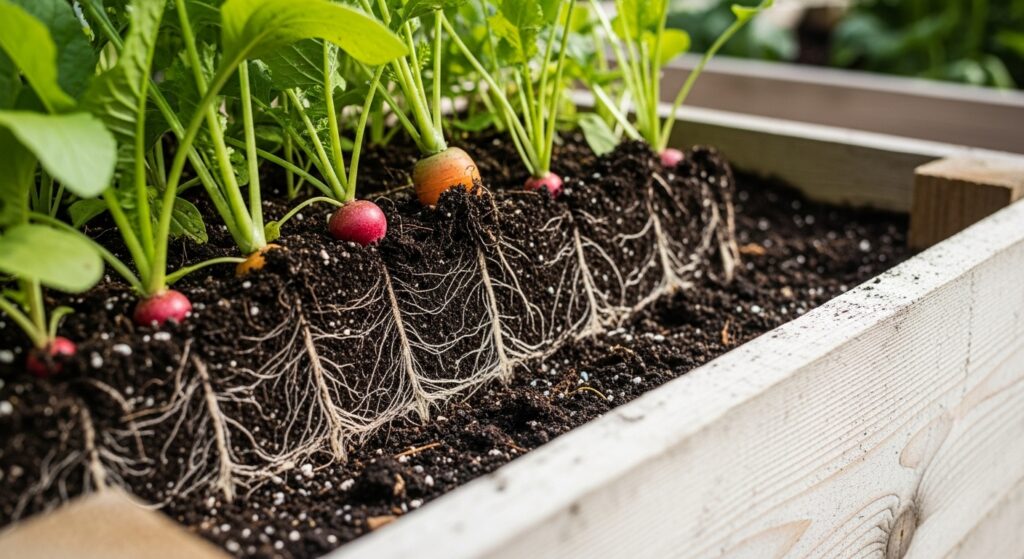
When building raised beds, it’s not just about how the structure looks or how much it costs. The materials you choose play a big role in:
1. Soil and Plant Health
Raised beds give you the chance to control soil conditions, but if the material itself contaminates the soil, that advantage is lost. For example, treated lumber often contains chemicals that can seep into the soil and damage delicate root systems or stunt plant growth.
2. Food Safety
If you’re growing vegetables, herbs, or fruit, safety becomes even more critical. You don’t want arsenic, creosote, or lead finding their way into your lettuce or carrots. Using non-toxic raised bed materials ensures your harvest is safe to eat.
3. Durability and Longevity
Safe materials don’t just mean chemical-free—they should also be sturdy and weather-resistant. You’ll want your raised beds to last several years without constant repairs. For instance, cedar naturally resists rot, while cheap untreated pine may only last a couple of seasons without care.
4. Environmental Impact
Eco-conscious gardeners also care about sustainability. Choosing recycled or reclaimed safe materials reduces waste and lowers your footprint. You’re not just protecting your plants—you’re protecting the planet.
Best Safe Materials for Raised Beds
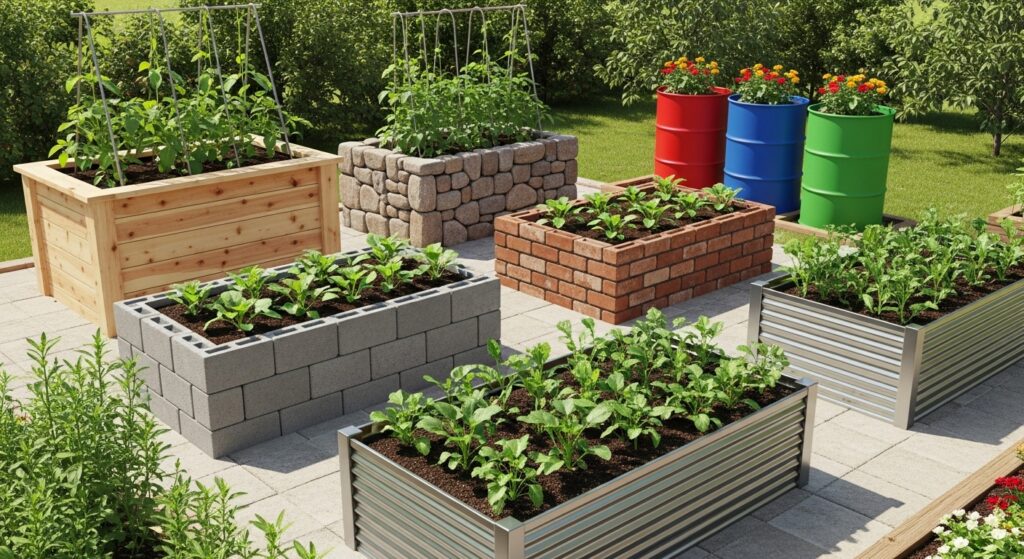
Let’s break down the top safe materials you can use to build strong, beautiful, and long-lasting raised beds.
1. Untreated Wood
Wood is a classic and widely available option. But the keyword here is untreated—meaning it hasn’t been chemically pressure-treated.
Cedar: Often considered the best wood for raised garden beds. Naturally rot-resistant, aromatic, and beautiful. Cedar can last 10–15 years outdoors with minimal maintenance. Learn more about the natural durability of cedar wood from USDA research.
Redwood: Similar to cedar, with natural oils that deter pests and decay. It’s durable but sometimes more expensive and less widely available.
Pine: More affordable and easy to find, but less durable than cedar or redwood. Untreated pine may last 3–5 years before it begins to rot, though sealing or lining the inside can extend its lifespan.
💡 Tip: If the budget is tight, pine is a great starter choice for DIY raised beds. For long-term investment, cedar or redwood is worth the cost.
2. Natural Stone
Stone is virtually indestructible and chemical-free. It provides excellent insulation for soil, keeping it cooler in summer and warmer in winter. Stone beds look timeless and blend naturally into landscaping. The main downside? They can be heavy and require more labor to build.
3. Bricks
Bricks are another natural and durable choice. They’re easier to handle than stone and offer a classic garden look. Bricks can be stacked dry or with mortar for extra strength. Just make sure to avoid reclaimed bricks that may have been exposed to harmful chemicals.
4. Concrete Blocks (Cinder Blocks)
Concrete blocks are sturdy, affordable, and easy to assemble. However, unsealed blocks can leach lime, which raises soil pH. This isn’t always a problem—some plants like alkaline soil—but sealing or lining the blocks prevents any issues. Learn more about the effects of concrete blocks on soil pH.
5. Galvanized Steel and Metal Beds
Metal raised beds have become very popular in recent years. They’re sleek, modern, and long-lasting. Galvanized steel is coated to prevent rust and is generally considered safe for gardening. Concerns about zinc leaching are minimal because soil pH levels in most gardens aren’t acidic enough to cause problems.
Still unsure? Here’s a science-backed answer from the University of Minnesota Extension: are galvanized steel raised beds safe?
Pre-fabricated metal garden bed kits are a great option for DIYers who want quick assembly and consistent results.
6. Recycled Plastic Lumber
Made from recycled plastic bottles and containers, this material is extremely durable, weather-resistant, and completely rot-proof. It won’t splinter, warp, or leach harmful chemicals. Plus, it comes in various colors and sizes, making it versatile for garden design. The downside is cost—it’s often more expensive than wood.
For more details, see EPA’s overview of the benefits of recycled plastic lumber.
7. Food-Grade Barrels or Containers
For a creative twist, consider using food-grade barrels or containers as raised beds. These are especially useful for small gardens, patios, or urban spaces. Just make sure the barrels are labeled food-safe (HDPE plastic #2 is a common safe choice) and haven’t stored harmful substances. Cut them in half, drill drainage holes, and you’ve got a budget-friendly, portable raised bed. And haven’t stored harmful substances. Cut them in half, drill drainage holes, and you’ve got a budget-friendly, portable raised bed.
💡 Pro Tip: Pair your material choice with the right Soil Mix for Raised Beds to maximize yield.
Materials to Avoid in Raised Beds
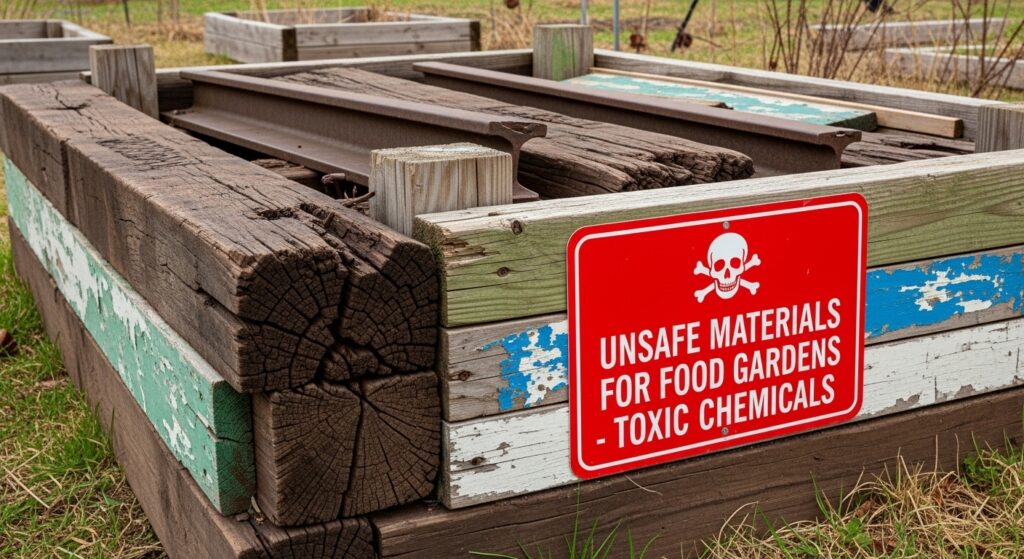
Not all materials are safe. Some may seem sturdy and cheap, but carry serious risks:
- Pressure-Treated Lumber: Historically treated with arsenic-based chemicals (CCA), which are toxic. Modern treated lumber is less dangerous but still contains copper compounds that can leach. Best avoided for food gardens.
- Railroad Ties: Often treated with creosote, a tar-like preservative that’s hazardous to plants, pets, and people. Learn more from Oregon State Extension on why you should avoid railroad ties in vegetable gardens.
- Painted or Stained Wood: Unless you know the paint is non-toxic and lead-free, avoid it. Old painted wood may contain lead.
- Low-Grade Plastics: Cheap plastics can break down under UV light and leach harmful chemicals into soil. If using plastic, make sure it’s food-grade and UV-resistant.
👉 If you’re unsure, check our guide on Best Vegetables for Raised Beds to see which crops are most sensitive to soil toxins.
Comparing Different Materials
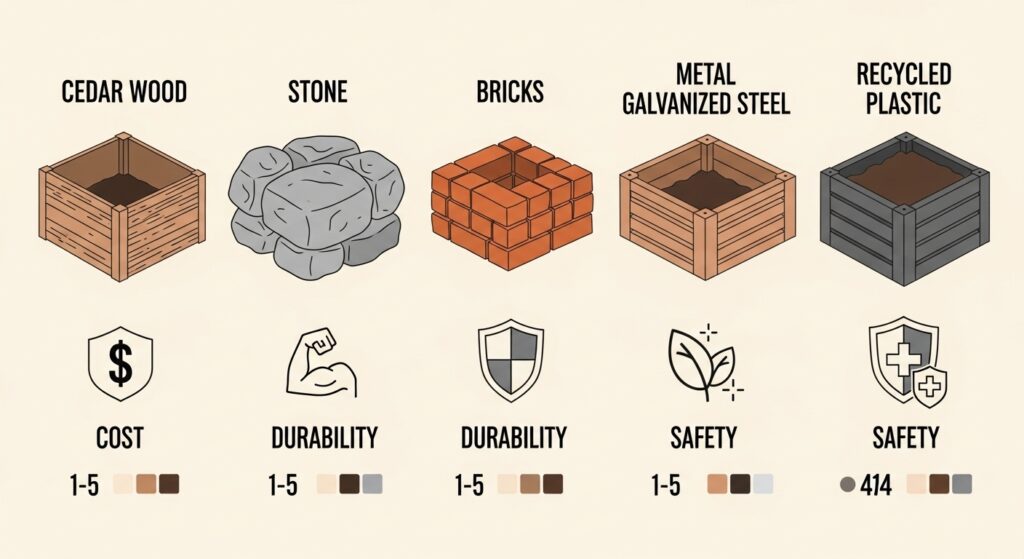
Here’s how the most popular safe materials stack up:
| Material | Cost | Durability | Aesthetics | Safety | Ease of DIY Use |
|---|---|---|---|---|---|
| Cedar/Redwood | Medium–High | 10–15 years | Natural, rustic | Very safe | Easy to cut/assemble |
| Pine (untreated) | Low | 3–5 years | Simple, rustic | Safe | Very easy |
| Stone | High | Lifetime | Elegant, natural | Very safe | Heavy, labor-intensive |
| Bricks | Medium | 20+ years | Classic look | Safe | Moderate |
| Concrete Blocks | Low–Medium | 10–20 years | Modern/industrial | Safe if sealed | Easy stacking |
| Galvanized Steel | Medium–High | 20+ years | Sleek, modern | Safe | Easy (kits available) |
| Recycled Plastic Lumber | High | 25+ years | Clean, modern | Very safe | Easy but costly |
| Food-Grade Barrels | Low | 10+ years | Unique, functional | Safe | Easy |
DIY Building Tips Using Safe Materials
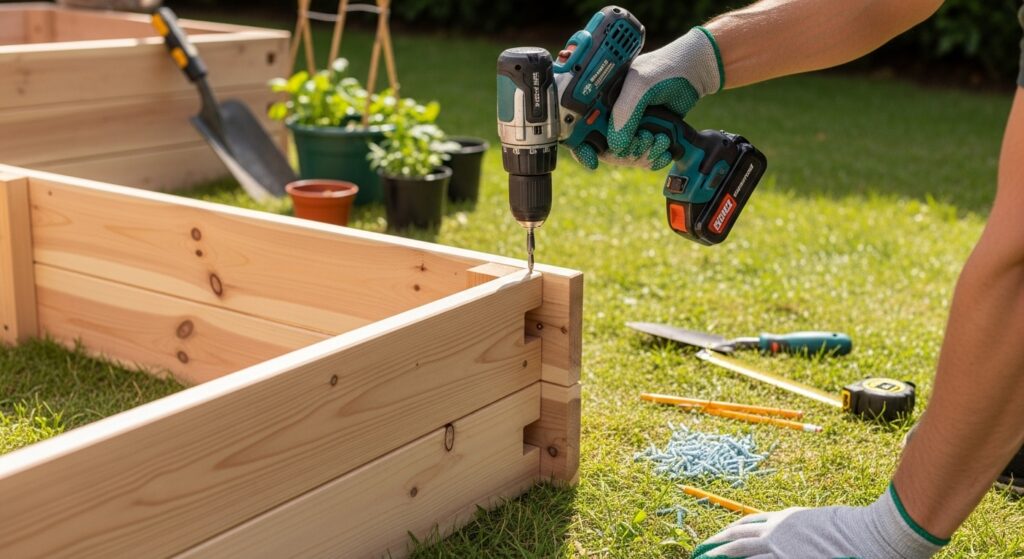
- Cutting & Assembly: Always wear gloves and eye protection when cutting wood or metal. Use stainless steel or galvanized screws/nails to prevent rust.
- Wood Treatment: If you want to extend the life of untreated wood, use natural oils (like linseed or tung oil) instead of chemical sealants. Beeswax and plant-based sealers are also good options.
- Sealing Options: If using concrete blocks, apply a non-toxic sealant to prevent lime leaching. For extra safety, line the inside with heavy-duty landscape fabric.
- Drainage Considerations: Drill holes in barrels and containers, and ensure beds have a layer of gravel or coarse material at the bottom to prevent waterlogging.
Eco-Friendly & Sustainable Options
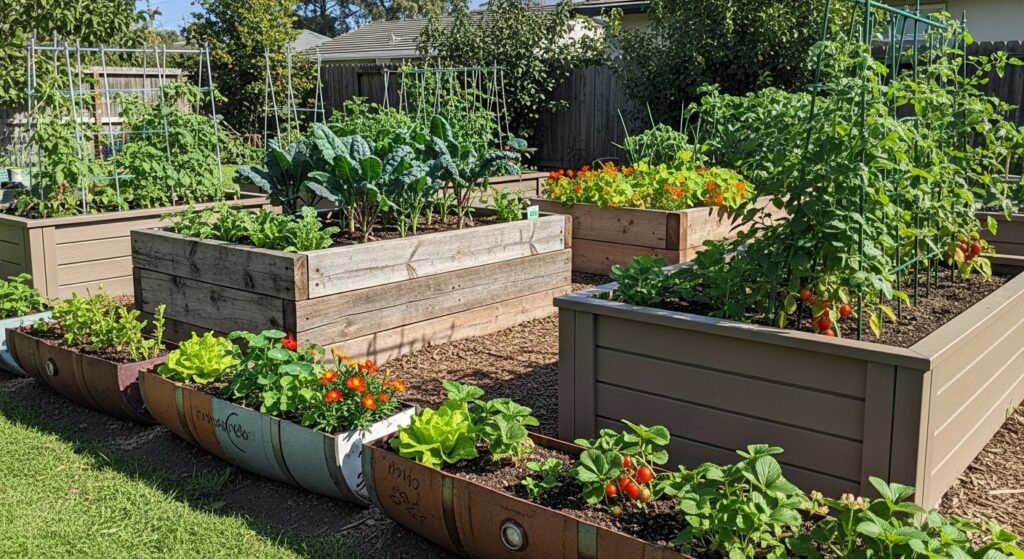
If you love the idea of reusing and recycling, there are plenty of eco-friendly ways to build safe raised beds:
- Reclaimed Wood: Salvage wood from old furniture or barns—but only if you’re sure it hasn’t been painted or treated with chemicals.
- Upcycled Materials: Old corrugated metal roofing, pallets (heat-treated, not chemically treated), or leftover construction stone can all be repurposed.
- Recycled Plastic Beds: Choosing recycled plastic lumber not only gives you durable beds but also helps reduce plastic waste in landfills. See EPA’s guide on how to recycle and upcycle materials.
These choices not only save money but also make your garden part of a sustainable lifestyle.
🌱 For inspiration, check out our Small Greenhouse Ideas to combine sustainability with year-round gardening.
Maintenance Tips for Safe Raised Beds
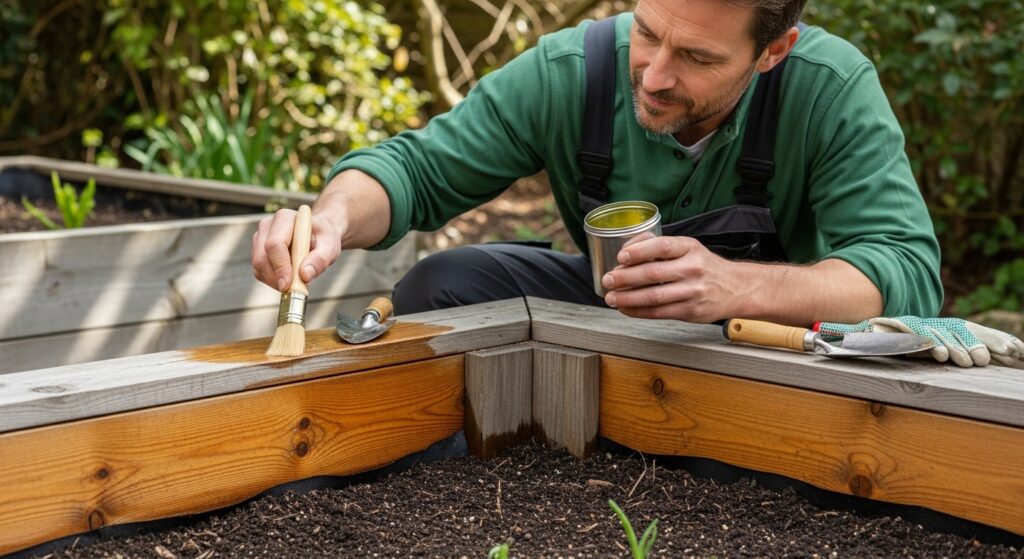
Even the safest materials need a little care:
- Check Annually for Wear: Look for rotting wood, rusting metal, or cracks in stone. Early repairs extend lifespan.
- Reapply Natural Oils to Wood: Once every 1–2 years, reapply linseed oil to keep moisture out. Here’s how the University of Minnesota explains wood rot prevention.
- Rotate Crops: To keep soil healthy, rotate vegetable families each season. This reduces disease buildup and prolongs the usefulness of your raised bed setup.
💡 Want step-by-step care routines? Read our Raised Bed Maintenance Guide for practical tips.
Common Mistakes to Avoid
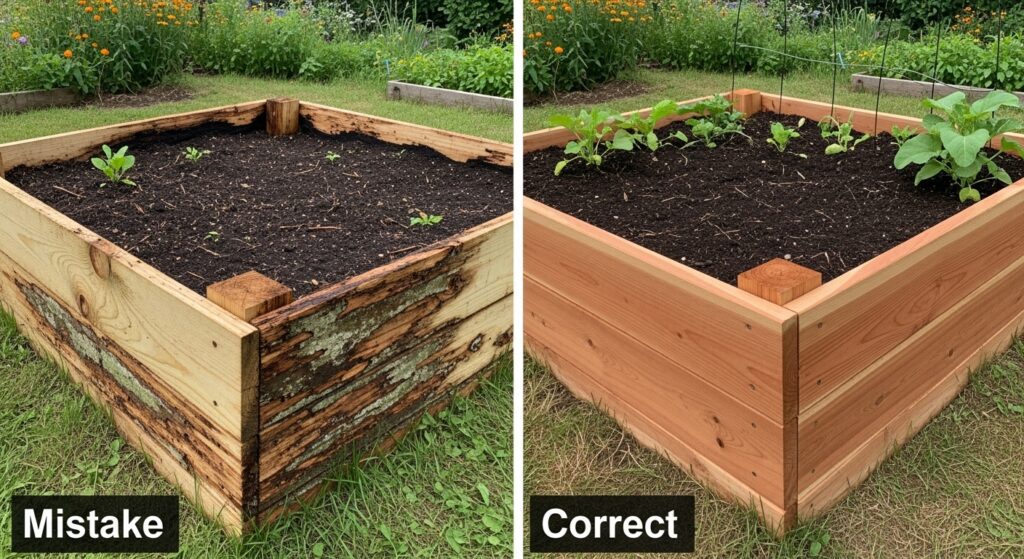
- Choosing Unsafe Materials: Don’t be tempted by free pressure-treated lumber or old railroad ties—they’re not worth the risk.
- Skipping Liners When Needed: For materials that may leach (like concrete), always line with a safe barrier.
- Poor Drainage: Without proper drainage, roots can suffocate, and beds deteriorate faster. Always plan for water flow.
- Overbuilding: Don’t make raised beds wider than 4 feet—you’ll have trouble reaching the middle without stepping on the soil.
❓ Frequently Asked Questions About Safe Materials for Raised Beds
1. Which safe materials for raised garden beds are easiest for beginners?
Answer: Untreated pine raised bed materials and concrete block raised beds are among the easiest to build. Pine is affordable and easy to cut, while concrete blocks can be easily stacked without the need for complex tools. Both are safe and ideal for DIY beginners.
2. How long do cedar or redwood raised beds last?
Answer: Cedar raised beds and redwood raised beds can last 10 to 15 years outdoors with minimal maintenance. Their natural oils resist rot, making them a durable and non-toxic choice for long-term raised gardening.
3. Is a galvanized steel raised bed toxic for growing vegetables?
Answer: No, galvanized steel raised bed kits are generally safe for growing vegetables. The zinc coating protects against rust, and under normal gardening conditions, only minimal leaching occurs. These beds offer modern looks and last over 20 years.
4. Are sealed concrete block raised beds safe for soil and plants?
Answer: Yes—sealed concrete block raised beds are safe. Unsealed blocks may raise soil pH due to lime content, but applying a non-toxic sealant or lining with landscape fabric prevents this. They’re budget-friendly and sturdy.
5. Can recycled plastic lumber be used safely for raised vegetable beds?
Answer: Absolutely. Recycled plastic lumber raised beds are non-toxic, durable, rot-resistant, and made from reclaimed materials—making them a sustainable, hassle-free option for eco-conscious gardeners.
6. What materials should to avoid in raised beds for food safety?
Answer: Avoid pressure-treated wood, especially older CCA-treated lumber; railroad ties (often treated with creosote); and painted or stained wood unless you know it’s lead-free. These materials can leach harmful chemicals into soil and food.
7. Do I need to line untreated wood beds to prevent rot?
Answer: While not mandatory, lining untreated wood beds (especially pine) with landscape fabric or using non-toxic wood oils (like linseed) can extend the lifespan by preventing direct soil contact that accelerates rot.
8. How deep should a raised bed be for common vegetables?
Answer: Ideally, most vegetables need 12–18 inches of soil depth. Shallow-rooted crops (like lettuce) may be happy in 8–10 inches, but deeper-rooted produce (like carrots or tomatoes) thrives in deeper beds.
9. What’s the most affordable safe raised bed material?
Answer: The most budget-friendly options are untreated pine and concrete blocks. Pine costs less but may last around 3–5 years unless protected; concrete blocks cost a bit more but are sturdy and low-maintenance.
Conclusion: Building a Safe, Healthy Garden
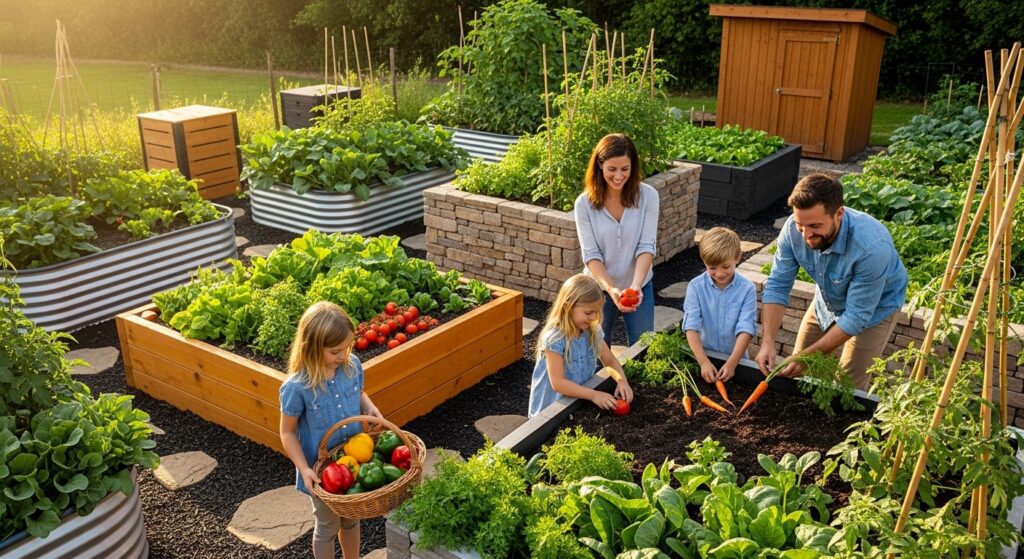
Your raised beds are more than just wooden or stone boxes—they’re the foundation of your gardening success. By choosing safe materials for raised beds, you’re ensuring healthier soil, stronger plants, and food that’s truly safe to eat.
Whether you go with the timeless look of cedar, the durability of galvanized steel, or the creativity of upcycled food barrels, the key is to prioritize non-toxic raised bed materials that will nurture your garden for years to come.
So, as you start your next DIY raised bed project, remember: safety, sustainability, and quality matter just as much as aesthetics and cost. With thoughtful choices, your raised beds will not only grow thriving plants but also reflect your commitment to a healthier home and planet.
🌱 Motivational Takeaway: Every seed you plant deserves a safe, nurturing space to grow. By building your raised beds with care and the right materials, you’re not just gardening—you’re investing in your health, your family’s food security, and a greener future.

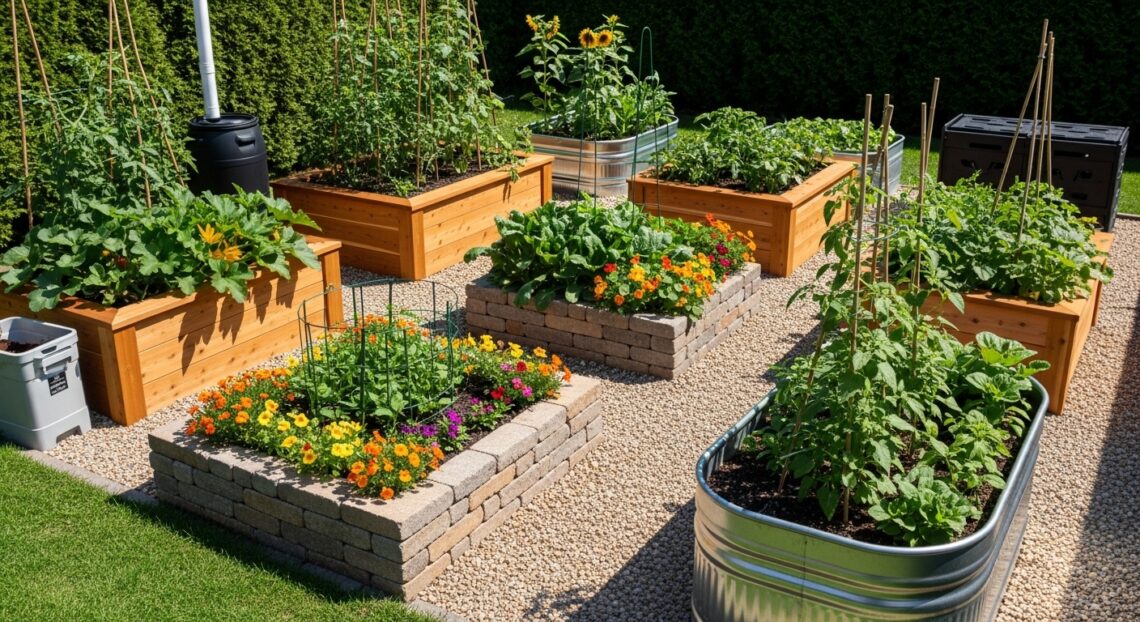
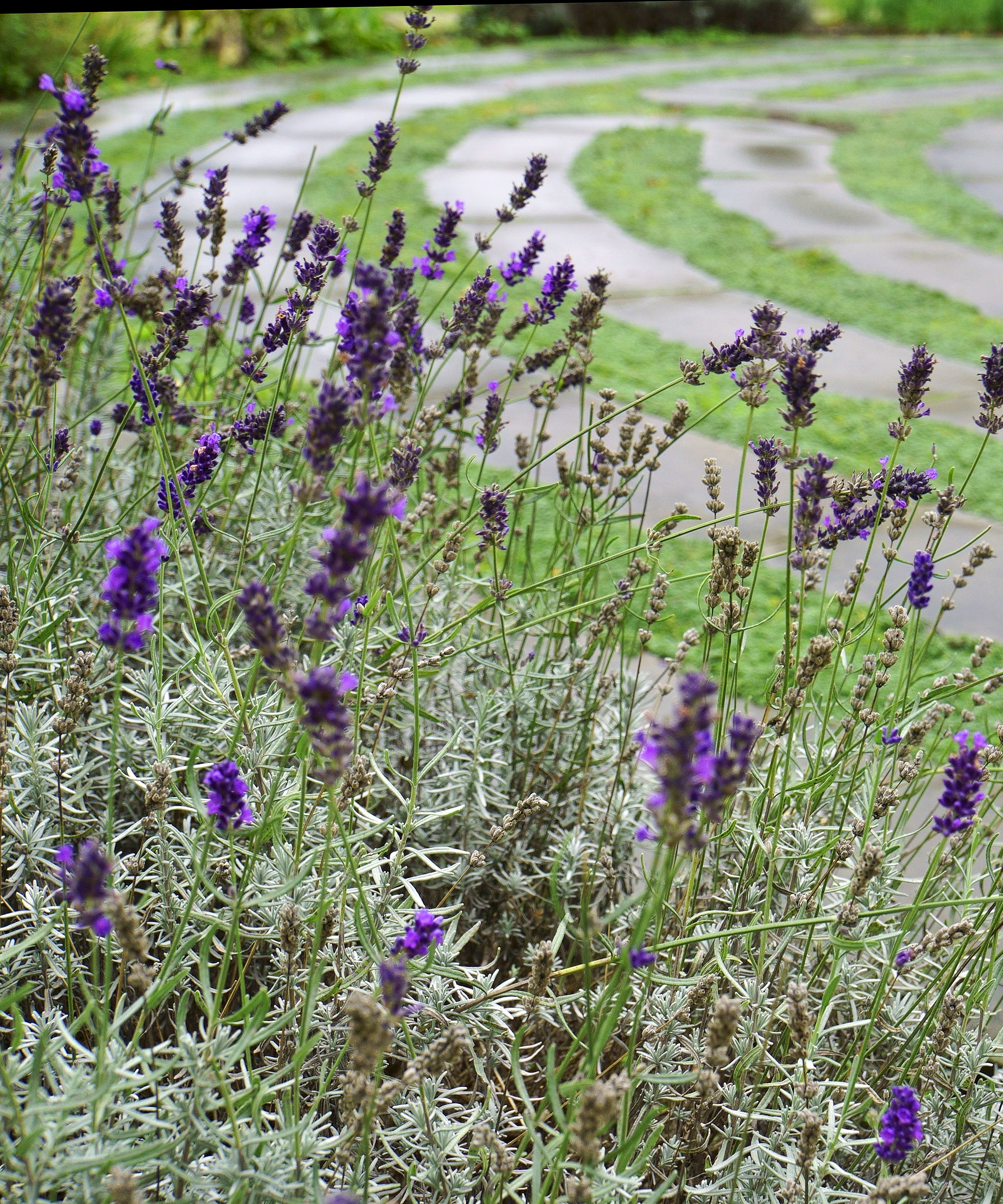
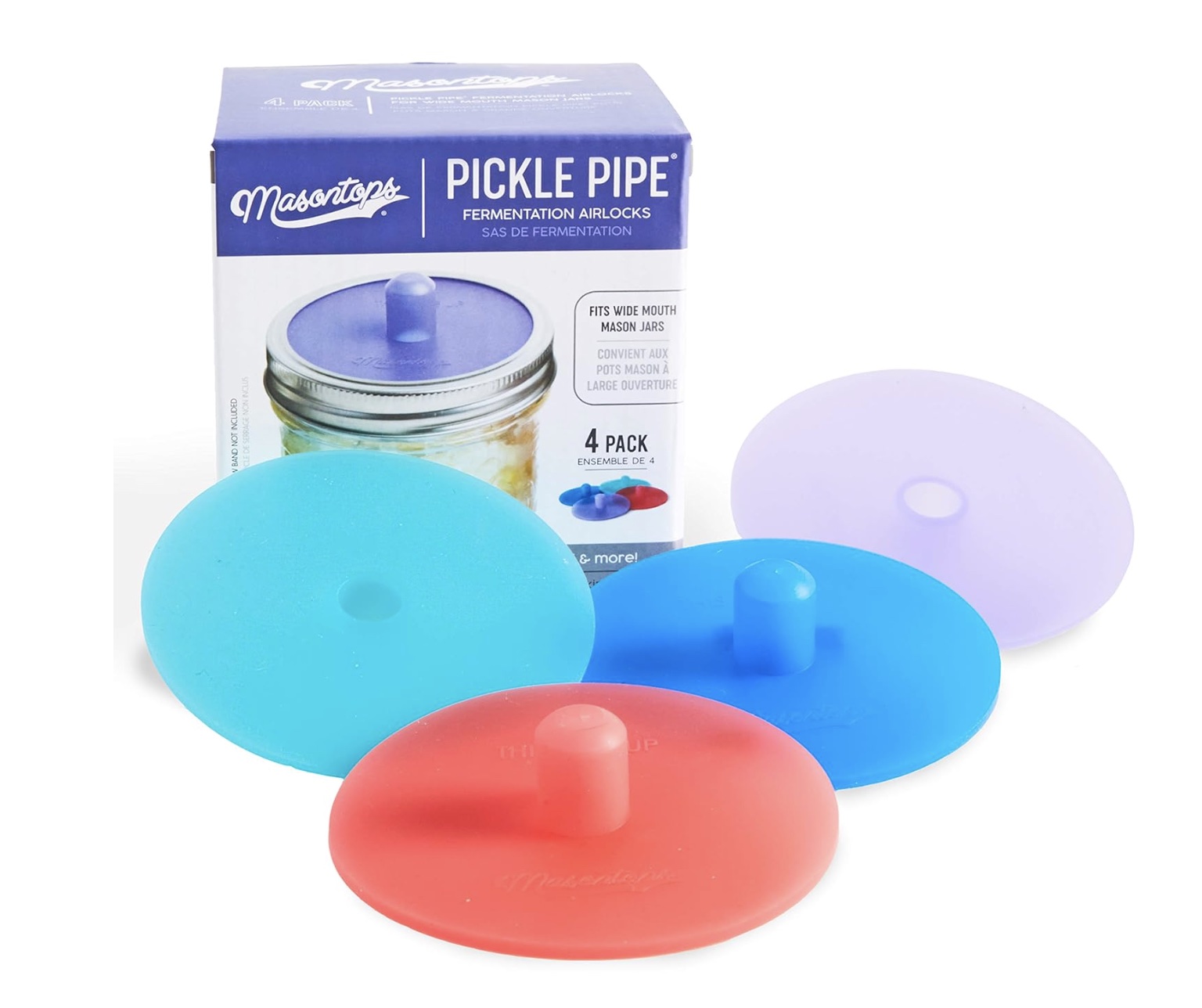
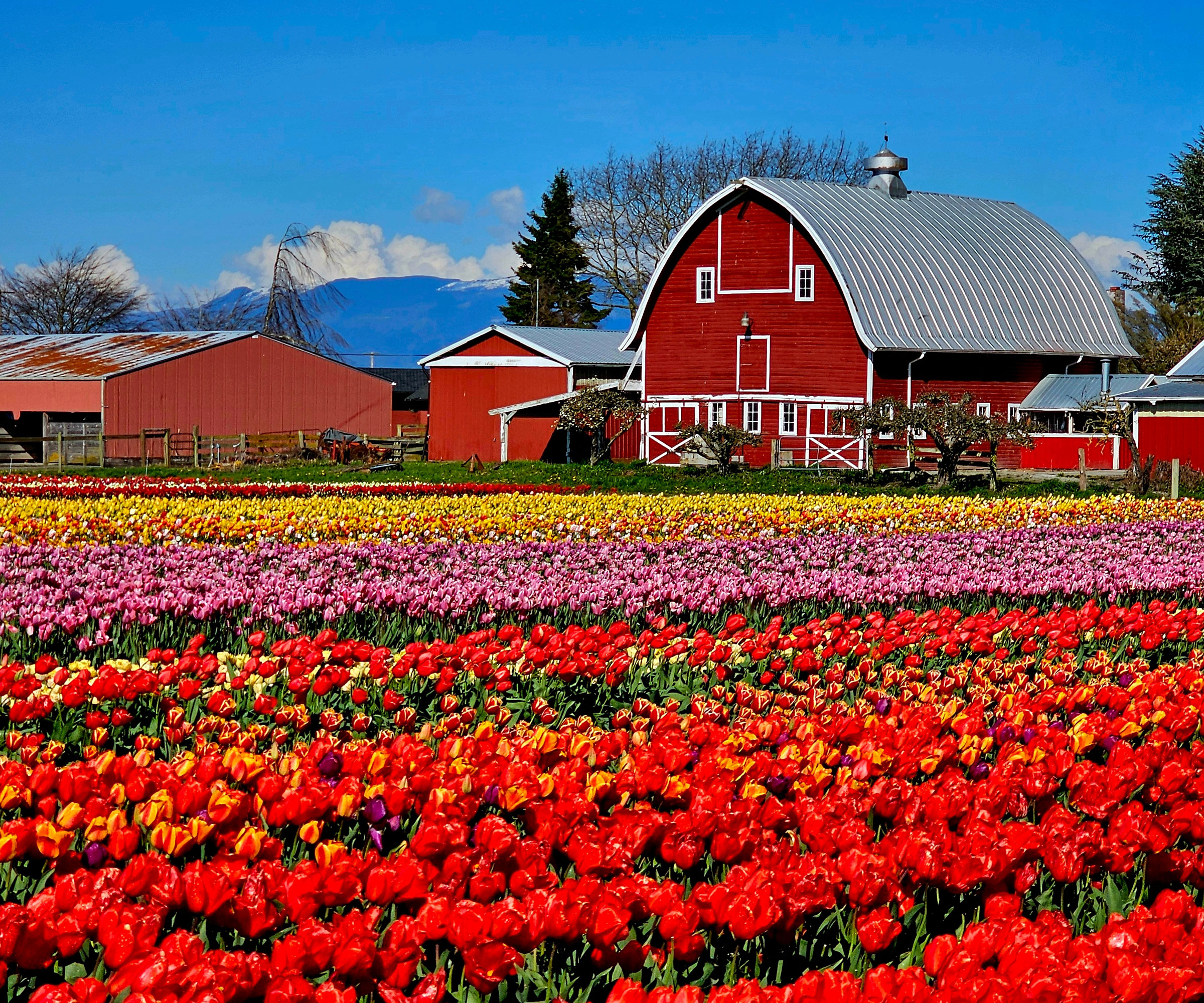
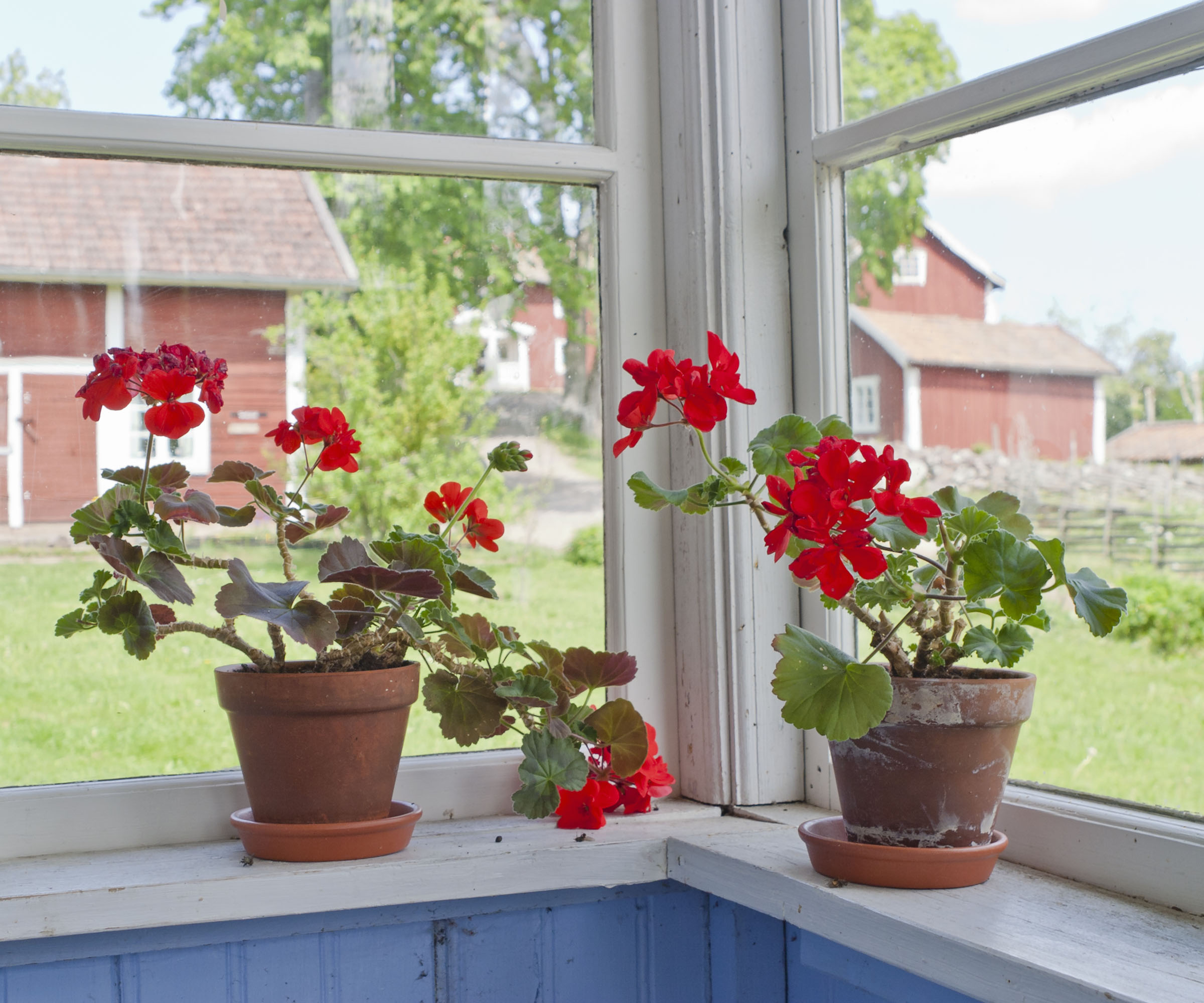
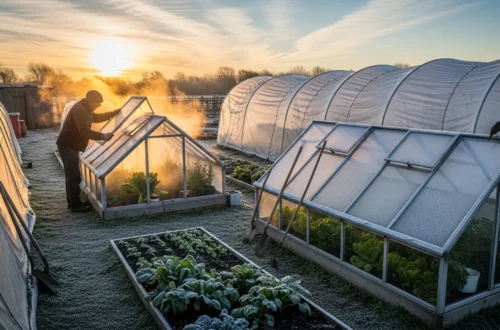
2 Comments on “Safe Materials for Raised Beds: A Complete Guide for Gardeners and DIY Enthusiasts”